|
Riders of the Clouds
The journey of Gilgamesh in search of Immortality has undoubtedly
been the fountainhead of the many tales, in subsequent millennia, of demi-Gods or heroes claiming such a status, who have likewise gone
to search for paradise on Earth or to reach the Celestial Abode of
the Gods. Without question, the detailed Epic of Gilgamesh also
served as a guide book in which the subsequent searchers sought to
find the ancient landmarks by which the Land of the Living could be
reached and the way to it ascertained.
The similarities between the geographic landmarks; the man-made (or
rather the God-made) tunnels, corridors, air locks and radiation
chambers; and the bird-like beings, or "Eagles," as well as many
other major and minor details—are far too numerous and identical to
be mere accidents. At the same time, the epic tale of the journey
can explain the confusion that reigned millenia later concerning the
exact location of the cherished target; because as our detailed
analysis has shown, Gilgamesh made not one but two journeys—a fact
generally ignored by modern scholars and possibly also by past ones.
The Gilgamesh drama reached its culmination in the Land of Tilmun,
an Abode of the Gods and a place of the Shems. It was there that he
encountered an ancestor who had escaped mortality, and had found the
secret plant of eternal youth. It was there that other divine
encounters, as well as events affecting the course of human history,
occurred in later millennia. It was there, we believe, that the Duat
was —the Stairway to Heaven,
But that was not the first destination of Gilgamesh, and we ought to
follow in his footsteps in the same sequence by which he himself had
embarked on his journey: his first destination on the road to
Immortality was not Tilmun, but the "Landing Place" on the Cedar
Mountain, within the great Cedar Forest.
Scholars (e.g. S. N. Kramer, The Sumerians) have termed as "cryptic
and still enigmatic" Sumerian statements that Shamash could "rise"
in the "Cedar Land," and not only in Tilmun. The answer is that
apart from the Spaceport at Tilmun, from which the farthest heavens
could be reached, there was also a "Landing Place" from which the
Gods "could scale the
skies" of Earth. This realization is supported by our conclusion,
that the Gods indeed had two types of craft: the GIRs, the
Rocketships that were operated from Tilmun; and what the Sumerians
called a MU, a "Sky Chamber." It is a credit to the technology of
the Nefilim that the uppermost section of the GIR, the Command
Module—what the Egyptians called Ben-Ben—could be detached and fly
in Earth's skies as a MU.
The ancient peoples had seen the GIRs in their silos (Fig. 27) or
even in flight (Fig. 75). But they depicted more frequently the "Sky
Chambers"— vehicles which we would nowadays classify as UFOs
(Unidentified Flying Objects).
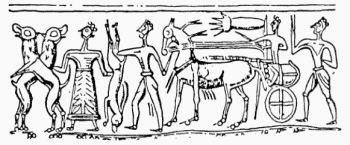
Fig. 75
The one the patriarch Jacob had seen
in his vision might well have looked like the Sky Chamber of Ishtar
(Fig. 66); the Flying Wheel described by the prophet Ezekiel was
akin to the Assyrian depictions of their Flying God roaming the
skies, at cloud level, within a spherical Sky Chamber (Fig. 76a).
Depictions found at an ancient site across the Jordan from Jericho,
suggest that for landing these spherical vehicles extended three
legs (Fig. 76b); they could well have been the fiery Whirlwinds in
which the prophet Elijah was carried off heavenwards at that very
same location.
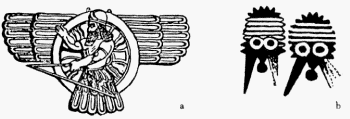
Fig. 76
As the Sumerian "Eagles," so were the
Flying Gods of antiquity
depicted by all ancient peoples as Gods equipped with wings—the
Winged Beings to whose depictions we can trace the Judeo-Christian
acceptance of the winged Cherubim and Angels (literally:
Emissaries)
of the Lord (Fig. 77).
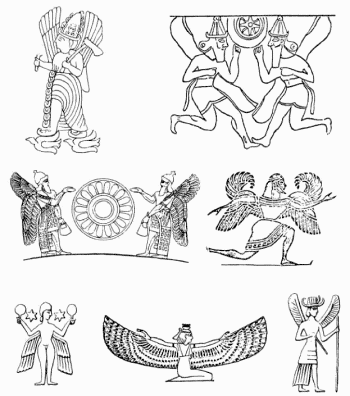
Fig. 77
Tilmun, then, was the location of the
Spaceport. The Cedar Mountain
was the location of the "Landing Place," the "Crossroads of Ishtar,"—the
Airport of the Gods. And it was to the latter that Gilgamesh had
first set his course.
While the identification of Tilmun and its location is no mean
challenge, there is little problem in locating the Cedar Forest.
With the exception of subsidiary growths on the island of Cyprus,
there is only one such location throughout the Near East: the
mountains of Lebanon. These majestic cedar trees, which can reach
150 feet in height, were repeatedly extolled in the Bible and their
uniqueness was known to the ancient peoples from the earliest times.
As the biblical and other Near Eastern texts attest, the Cedars of
Lebanon were earmarked for the construction and decoration of
temples ("Gods' houses")—a practice described in detail in I Kings,
in the chapters dealing with the building of the Jerusalem Temple by
Solomon (after the Lord Yahweh had complained "Why build ye not me a
House of cedar?").
The biblical Lord appears to have been quite familiar with the
cedars, and frequently employed them in his allegories, comparing
rulers or nations to cedars: "Assyria was a cedar in Lebanon, with
fair branches and a shadowing shroud and of high stature ...
waters nourished it, subterranean streams gave it height"—until the
wrath of Yahweh toppled it and smashed its branches. Man, it
appears, had never been able to cultivate these cedars; and the
Bible records an attempt that had completely failed.
Attributing the
attempt to the king of Babylon (factually or allegorically), it is
stated that "He came to Lebanon and took the cedar's highest
branch," selecting off it a choice seed. This seed "he planted in a
fruitful field, he placed it by great waters." But what grew up was
not a tall cedar—only a willow-like tree, "a spreading vine of low
stature."
The biblical Lord, on the other hand, knew the secret of cedar
cultivation:
Thus sayeth the Lord Yahweh: "From the cedars crest, from its
topmost branches a tender shoot I will take; and I will plant it
upon a high and steep mountain ... And it will put forth branches,
and bear fruit, and become a mighty cedar."
This knowledge apparently stemmed from the fact that the cedar grew
in the "Orchard of the Gods." There, no other tree could match it;
"it was the envy of all the trees that were in Eden, the garden of
the Gods."
The Hebrew term Gan (orchard, garden), stemming as it
does from the root gnn
(protect, guard), conveys the sense of a guarded and restricted
area—the same sense as is imparted to the reader of the Gilgamesh
narrative: a forest that extends "for many leagues," watched over by
a Fiery Warrior ("a terror to mortals"), accessible only through a
gateway which paralyzed the intruder who touched it. Inside, there
was "the secret abode of the Anunnaki"; a tunnel led to "the
enclosure from which words of command are issued"—"the underground
place of Shamash."
Gilgamesh almost made it to the Landing Place, for he had the
permission and help of Shamash. But the wrath of Ishtar (when he
turned down her advances) completely reversed the course of events.
Not so, according to the Old Testament, was the fate of another
mortal king. He was the king of Tyre—a city-state on the coast of
Lebanon, a short distance
away from the cedar mountains; and the Deity (as told in chapter 28
of the Book of Ezekiel) did enable him to visit the Sacred Mountain:
Thou hast been in Eden, the Garden of God; every precious stone was
thy thicket ... Thou art an annointed Cherub, protected; and I
have placed thee in the Sacred Mountain. As a God werest thou,
moving within the Fiery Stones.
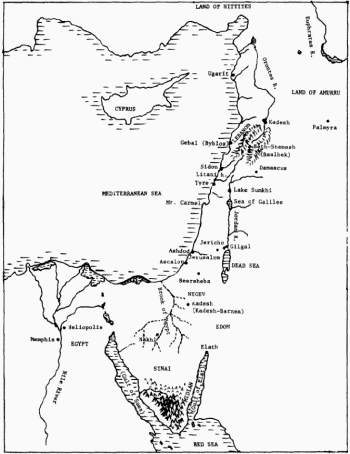
Fig. 78
Gilgamesh sought to enter the Landing Place of the Gods uninvited;
the king of Tyre not only was permitted to come to the place, but
evidently was also given a ride in "the fiery stones," flying as a
Cherub. As a result, "a God I am," he said; "in the Abode of the
Deity I sat, in the midst of the waters." For his haughtiness of
heart, the prophet was to inform him, he was to die the death of a
heathen by the hands of strangers.
Both the Hebrews of biblical times, and their neighbors to the
north, were thus acquainted with the location and nature of the
Landing Place in the Cedar Mountain which Gilgamesh attempted to
penetrate in a previous millennium. It was, as we shall show, not a
"mythological" place, but a real one: not only texts, but also
pictorial depictions exist from those ancient days, attesting to the
existence and functions of the place.
In the tale of the king who tried to grow a cedar, the Old Testament
reports that he "carried off the twig to a land of commerce," and
planted the seed "in a city of merchants." Such a land and such
cities-of-merchants need not have been looked-for far: along the
coast of Lebanon, from where Anatolia begins in the north to
Palestine in the south, there were several Canaanite coastal cities
whose wealth and power grew with their international commerce. Best
known from biblical narratives were Tyre and Sidon; centers of trade
and shipping for millennia, their fame reached its peak under their
Phoenician rulers.
In ruins and buried under a mount since its destruction by Assyrian
invaders lay yet another city, perhaps the northernmost outpost of
the Canaanites at the borders of the Hittite empire. Its remains
were accidentally uncovered in 1928 by a farmer who set out to
plough a new field near the mount called Ras Shamra. The extensive
excavations that followed uncovered the ancient city of Ugarit. The
spectacular finds included a large palace, a temple to the God Ba'al
("The Lord"), and a variety of artifacts.
But the real treasures
were scores of clay tablets inscribed in an alphabetic cuneiform
script (Fig. 79), written in a "Western-Semitic" language akin to
biblical Hebrew. The tablets, whose contents were first presented by
Charles Virollaud over many years in the scientific periodical
Syria, retrieved from relative obscurity the Canaanites, their life
and customs, and their Gods.
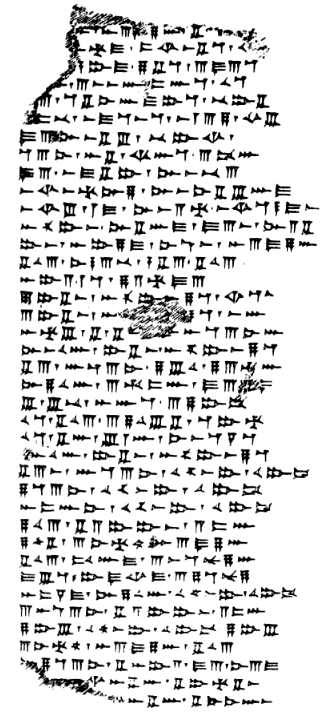
Fig. 79
At the head of the Canaanite pantheon was a supreme deity called
El—a term which in biblical Hebrew was the generic term for "deity,"
stemming as it did from the Akkadian word Ilu, which literally meant
"Lofty One." But in the Canaanite tales of Gods and men,
El was the
personal name of an actual deity, who was the final authority in all
affairs be they divine or human. He was father of the Gods, as well
as Ab Adam ("father of men"); his epithets were The Kindly,
The
Merciful. He was "creator of things created" and the "one who alone
could bestow kingship."
A stela found in Palestine (Fig. 80) depicts
El seated on his throne and being served a beverage by a younger
deity, probably one of his many sons. El wears the conical, horned
headdress which was the recognition mark of the Gods throughout the
ancient Near East; and the scene is dominated by the omnipresent
Winged Globe, emblem of the
Planet of the Gods.

Fig. 80
In "olden times," El was a principal deity of Heaven and Earth. But
at the time at which the events related in the tablets had taken
place, El lived in semi-retirement, aloof from daily affairs. His
abode was "in the mountains," at "the two headwaters."
There he sat
in his pavilion, receiving emissaries, holding councils of the Gods,
and trying to resolve the recurring disputes among the younger Gods.
Many of these were his own children: some texts suggest that El may
have had seventy offspring.

Fig.81
Of them, thirty were by
his official
consort Asherah (Fig. 81); the others, by an assortment of
concubines or even by human females. One poetic text tells how two
females saw El naked as they were strolling on the beach; they were
completely charmed by the size of his penis, and ended up each
bearing him a son. (This attribute of El is prominent in a depiction
of him, as a winged God, on a Phoenician coin—Fig. 82).
El's principal children, however, were three sons and one daughter:
the Gods Yam ("Ocean, Sea"), Ba'al ("Lord") and
Mot ("Smiter,
Annihilator") and the Goddess Anat ("She Who Responded"). In names
and relationships they clearly paralleled the Greek Gods Poseidon (God of the
Seas), Zeus (Lord of the Gods) and Hades (God of the Lower World). Ba'al, as Zeus, was always armed with a lightning-missile (Fig. 82),
the bull his cult symbol.
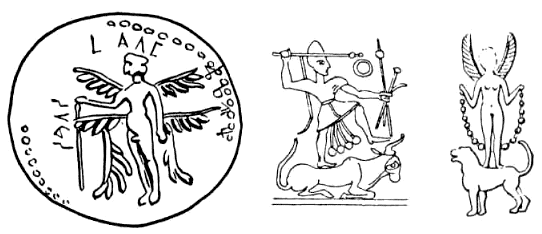
Fig. 82
When Zeus fought Typhon, it was his sister
Athena, Goddess of War and Love, who alone stood by him; and in
Egyptian tales, Isis alone stood by her brother-husband Osiris.
So
it was when Ba'al fought his two brothers: his sister-lover
Anat
alone came to his help. Like Athena, she was on the one hand "The
Maiden," often flaunting her naked beauty (Fig. 82); and on the
other hand the Goddess of War, the lion a symbol of her bravery
(Fig. 83). (The Old Testament called her Ashtoreth.)
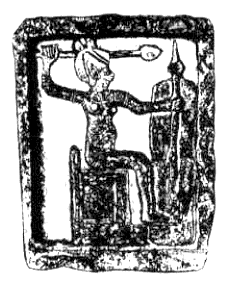
Fig. 83
The links to Egyptian prehistorical recollections and beliefs were
no less obvious than to those of Greece. Osiris was resurrected by
Isis after she had found his remains at the Canaanite city of
Byblos. Likewise, Ba'al was brought back to life by Anat after he
was smitten by Mot. Seth, the adversary of Osiris, was sometimes
called in Egyptian writings "Seth of Saphon"; Ba'al, as we shall
see, acquired the title "Lord of Zaphon."
Egyptian monuments of the
New Kingdom—paralleling the Canaanite period—often depicted the
Canaanite Gods as Egyptian deities, calling them Min, Reshef,
Kadesh, Anthat (Fig. 84). We thus find the same tales applying to
the same Gods, but under different names, throughout the ancient
world.
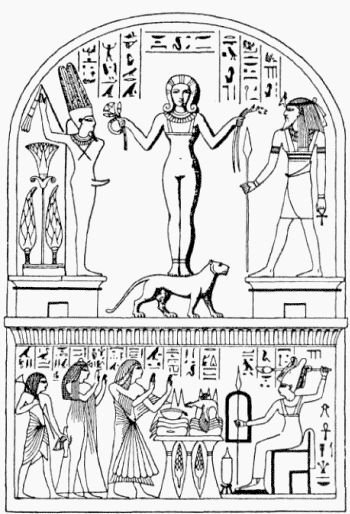
Fig. 84
Scholars have pointed out that all these tales were echoes, if not
actual versions, of the much earlier and original Sumerian tales:
not only of Man's Search for Immortality, but also of love, death
and resurrection among the Gods. All along, the tales are replete
with episodes, details, epithets, and teachings which also fill the
Old Testament—attesting to a common locale (greater Canaan), common
traditions and common original versions.
One such text is the tale of Danel (Dan-El—"El's judge"—Daniel in
Hebrew), a righteous chieftain who could not beget a rightful heir.
He appealed to the Gods to give him one, so that when he died, the
son could erect a stela in his memory at Kadesh. From this we
surmise that the area of the tale's events was where southern Canaan
(the Negev) merges into the Sinai peninsula, for it was there that
Kadesh ("The Sacred" city) was located.
Kadesh was encompassed in the territory of the biblical Patriarch
Abraham; and the Canaanite tale of Danel is indeed replete with
similarities to the biblical tale of the birth of Isaac to the aging
Abraham and Sarah. Much as in the Book of Genesis, we read in the
Canaanite tale that Danel, getting on in years without a male heir,
saw his chance to get divine help when two Gods arrived at his
habitat.
"Forthwith ... he gives offering to the
Gods to eat, gives
offering to drink to the Holy Ones."
The divine guests—who turn out
to be El, "The Dispenser of Healing," and Ba'al— stay with Danel a
whole week, during which he overwhelms them with his supplications.
Finally Ba'al "approaches
El with his (Danel's) plea."
Yielding, El "by the hand takes his servant" and grants him "Spirit"
whereby Danel's virility is restored: With life-breath Danel is quickened... With life-breath he is
invigorated.
To the disbelieving Danel, El promises a son. Mount your bed, he
tells him, kiss your wife, embrace her ... "by conception and
pregnancy she will bear a male child to Danel." And just as in the
biblical tale, the matriarch does bear a Rightful Heir, and the
Succession is assured. They name him Aqhat, the Gods nickname him
Na'aman ("The Pleasant One").
As the boy grows to be a young man, the Craftsman of the Gods
presents him with a gift of a unique bow. This soon arouses the envy
of Anat, who wishes to possess the magical bow. To get it, she
promises Aqhat anything he would like to have—silver, gold, even
Immortality:
Ask for Life, O Aqhat the youth—Ask for Life and I will grant it to
thee;
For Immortality (ask),
and I will bestow it upon thee.
With Baal I will make thee count the
years;
With the sons of El shalt thou count the months.
Moreover—she promised—not only would he live as long as the Gods,
but he would be invited to join them for the Lifegiving ceremony:
And Baal, when he grants Life,
a feast he gives; A banquet he holds for the One-Given-Life. He bids
him a drink,
sings and chants over him sweetly.
But Aqhat does not believe that Man can escape his mortal fate, and
does not wish to part with the bow:
Lie not, O Maiden—
to a hero thy lies are loathesome. How can a mortal an Afterlife
acquire? How can a mortal Eternity obtain? ... The death of all
men will I die; Yea, I shall surely die.
He also points out to Anat that the bow was made for warriors like
himself and not for a female to use. Insulted, Anat "traverses the
land" to El's abode, to seek permission to smite Aqhat. El's
enigmatic response permits punishment only up to a point.
Now Anat turns to cunning. "Over a thousand fields, ten thousand
acres" she travels back to Aqhat. Pretending to be at peace and in
love with him, she laughs and giggles. Addressing him as "Aqhat the
youth," she states: "Thou are my brother, I am thy sister." She
persuades him to accompany her to the city of "The Father of the
Gods; the Lord of the Moon." There she asks Taphan to "slay Aqhat
for his bow" but then "make him live again"—to put Aqhat to
temporary death, only long enough for Anat to take away his bow.
Taphan, following Anat's instructions, "smites Aqhat twice on the
skull, thrice above the ear," and Aqhat's "soul escapes like vapor."
But before Aqhat can be revived—if
Anat had ever so intended—his
body is ravaged by vultures. The terrible news is brought to Danel
as, "sitting before the gate, under a mighty tree, he "judges the
cause of the widow, adjucates the case of the orphan." With Baal's
aid, a search is instituted for the dismembered Aqhat, but to no
avail. In revenge, Aqhat's sister, in disguise, travels to the abode
of Taphan and, getting him drunk, attempts to slay him. (A possible
happy end, wherein Aqhat was resurrected after all. is missing.)
The transfer of action from the mountains of Lebanon to the "City of
Lord Moon" is also an element found in the Gilgamesh epic.
Throughout the ancient Near East, the deity associated with the Moon
was Sin (Nannar in the original Sumerian). His Ugaritic epithet was
"Father of Gods"; he indeed was the father of Ishtar and her
brothers. The first attempt of Gilgamesh to reach his goal via the
Landing Place in the Cedar Mountain was frustrated by Ishtar, who
sought to have him killed by the Bull of Heaven after he rejected
her advances. Undertaking the second journey toward the Land Tilmun,
Gilgamesh too arrived at a walled city "whose temple to Sin was
dedicated."
But whereas Gilgamesh arrived in the region of Sin after a long and
hazardous trek, Anat—like Ishtar—could get around from place to
place in no time—for she neither walked nor traveled on assback;
instead, she flew from place to place. Many Mesopotamian texts
referred to Ishtar s flying journeys and her ability to roam in
Earth's skies, "crossing heaven, crossing earth." A depiction of her
in her temple in Ashur, an Assyrian capital, showed her wearing
goggles, a tight-fitting helmet and extended "ear-phones" or panels
(see Fig. 58).
In the ruins of Mari on the Euphrates River, a
life-sized statue of a Goddess was found, equipped with a "black
box," a hose, a horned helmet with built-in earphones and other
attributes of an aeronaut (Fig. 85). This ability "as a bird to
fly," also attributed to the Canaanite deities, features in all the
epic tales discovered at Ugarit.
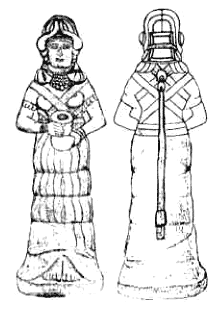
Fig. 85
One such tale, in which a Goddess flies to the rescue, is a text
titled by scholars "The Legend of King Keret"—Keret being capable of
interpretation as the king's personal name, or the name of his city
("The Capital"). The tale's main theme is the same as that of the
Sumerian epic of Gilgamesh: Man's striving for Immortality. But it
begins like the biblical tale of Job, and has other strong biblical
similarities.
Job, according to the biblical tale, was a righteous and "pure" man
of great wealth and power who lived in the "Land of Utz" (the "Land
of Advice"), a land in the domain of the "Children of the East." All
went well until "one day, when the sons of the Gods came to present
themselves to the Lord, Satan came also among them."
Persuading the
Lord to test Job, Satan was permitted to afflict him first with the
loss of his children and all his wealth, and then with all manner of
sickness. As Job sat mourning and suffering, three of his friends
came to console him; the Book of Job was composed as a record of
their discussions concerning matters of life and death and the
mysteries of Heaven and Earth.
Bewailing the turn of events, Job longed for the days of yore, when
he was honored and respected: "at the gates of Keret, in the public
square, my seat was at the ready." In those days, Job reminisced, he
believed that "as the Phoenix shall be my days, with my Establisher
shall I die." But now, with nothing left and afflicted with
illnesses, he felt like dying then and there.
The friend who had come from the south reminded him that "Man is
born unto travail; only the son of Reshef can to the heights fly
up"; Man was mortal after all, so why this extreme agitation?
But Job answered enigmatically that it was not so simple:
"The
Lord's Essence is within me," he said; "its radiance feeds my
Spirit."
Was he disclosing, in the hitherto uncomprehended verse,
that he was of partly divine blood? That, therefore, like Gilgamesh,
he had expected to live as long as the ever-rejuvenating Phoenix, to
die only when his "Establisher" shall die. But now he realized that
"Eternally I shall no longer live; like vapor are my days."
The tale of Keret too depicts him at first as a prosperous man who
loses in quick succession his wife and children through sickness and
war. "He sees his offspring ruined ... in its entirety a posterity
perishing," and realizes that it is the end of his dynasty: "wholly
undermined is his throne." His mourning and grief grow daily; "his
bed is soaked by his weeping." Daily "he enters the inner chamber"
in the temple and cries to his Gods. Finally,
El "descends unto him" to find out "what ails Keret that he weeps."
It is then that the texts disclose that Keret is partly divine, for
it was El who had fathered him (by a human female).
El advises his "beloved lad" to stop mourning, and to remarry, for
he would be blessed with a new heir. He is told to wash and make
himself presentable, and go seek the hand of the daughter of the
king of Udum (possibly the biblical Edom). Keret, accompanied by
troops and laden with gifts, goes to Udum and does as El had
instructed. But the king of Udum turns down all the silver and gold.
Knowing that Keret "is the flesh of the Father of Men"—of divine
origins—he asks for a unique dowry: let the firstborn son that his
daughter shall bear Keret also be semi-divine!
The decision is, of course, not up to Keret. El, who had given him
the marriage counsel to begin with, is not available. Keret
therefore sets his steps to the shrine of Asherah, and seeks her
help. The next scene takes place at the abode of El, where the
appeal of Asherah is supported by the younger Gods:
Then came the companies of the Gods.
And puissant Ba'al spake up:
"Now
come, O Kindly One, El benign:
Will thou not bless Keret the pure
blooded
nor please the beloved lad of El?"
Thus prodded, El consents and "blesses Keret," promising him that he
shall have seven sons and several daughters. The firstborn son, El
announces, is to be named Yassib ("Permanent") for indeed he will be
granted permanence. This will be achieved because when he is born,
not his mother but rather the Goddesses Asherah and Anat will suckle
him. (The theme of a king's child being nursed by a Goddess, thereby
being granted longer life, was depicted in the art of all the Near
Eastern peoples—Fig. 86).

Fig. 86
The Gods keep their promises; but
Keret, growing in wealth and
power, forgets his vows; in the manner of the king of Tyre in the
prophecies of Ezekiel, his heart grew haughty, and he began to boast
to his children about his divine origins. Angered, Asherah afflicted
him with a fatal disease. As it became clear that Keret was on the
verge of death, his sons were astonished: How can this happen to
Keret, "a son of El, an offspring of the Kindly One, a holy being?"
In disbelief, the sons question their father—for surely his failed
claim to Immortality has a bearing on their own lives as well:
In thy Life, father, we rejoiced;
We exalted in thy Not-dying ...
Wilt thou die then, father, like the mortals?
Their father's silence speaks for itself, and now the sons turn to
the Gods:
How can it be said,
"A son of El is Keret,
an offspring of the Kindly One
and a holy being?"
Shall then a God die?
An offspring of the Kindly One not live?
Embarrassed, El asks the other Gods: "Who among the Gods can remove
the sickness, drive out the malady?" Seven times El issued this
appeal, but "none among the Gods answers him." In desperation,
El
appeals to the Craftsman of the Gods and his assistants, the
Crafts-Goddesses who know all magic. Responding, the "female who
removes illness," the Goddess Shataqat, takes to the air. "She flies
over a hundred towns, she flies over a multitude of villages. ..."
Arriving in the house of Keret in the nick of time, she manages to
revive him.
(The tale, though, has no happy end. Since Keret's claim to
Immortality had proven vain, his firstborn son suggested that Keret
abdicate in his favor... .)
Of greater importance to the understanding of ancient events are the
several epic tales dealing with the Gods themselves. In these, the
ability of the Gods to fly about is accepted as a matter of course;
and their haven in the "Crest of Zaphon" is featured as the
aeronauts' resting place. The central figures in these tales are
Ba'al and Anat, the brother-sister who are also lovers. Ba'al's
frequent epithet is "The Rider of the Clouds"—an epithet which the
Old Testament has claimed for the Hebrew deity. Anat's own flying
capabilities, which became apparent in the tales dealing with the
relations between Gods and men, are even more highlighted in the
tales of the Gods themselves.
In one such text, Anat is told that Ba'al went to fish "in the
meadow of Samakh" (Fig. 87).
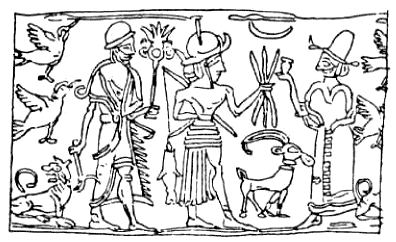
Fig. 87
The area happens to still be called by
that very name to this day: it is Lake Sumkhi ("Lake of Fishes") in
northern Israel, where the Jordan River begins to flow into the Sea
of Galilee; and it is still renowned for its fishes and wildlife.
Anat decided to join Ba'al there:
She raises wing, the Maiden Anat,
she raises wing and tours about flying
to the midst of the meadow of Samakh
which with buffaloes abounds.
Seeing her, Ba'al signaled her to come down; but
Anat began to play
hide-and-seek. Annoyed, Ba'al asked whether she expects him to,
"anoint her horns"—a lovemaking expression—"while in flight." Unable
to find her, Ba'al took off "and went up... in the skies" unto his
throne-seat on the
"Crest of Zaphon." The playful Anat soon appeared there too, "upon
Zaphon in pleasure (to be)."
The idyllic get-together, however, could take place only in later
years, when the position of Ba'al as the Prince of Earth and
acknowledged master of the northern lands was finally established.
Earlier, Ba'al engaged in life-and-death struggles with other
contenders for the Godly throne; the prize of all these fights was a
place known as Zarerath Zaphon—commonly translated "the Heights of
Zaphon," but specifically meaning "The Rocky Crest in the North."
These bloody struggles for dominion over certain strongholds or
lands were compounded by the positioning for succession, as the head
of the pantheon grew old and semi-retired. Conforming to marriage
traditions first reported in the Sumerian writings,
El's official
consort Asherah ("the Ruler's daughter") was his half-sister. This
made the first son born by her the rightful heir. But, as had
happened before, he was often challenged by the firstborn—a son who
chronologically was born first, but by another mother. (The fact
that Ba'al, who had at least three wives, could not marry
his beloved Anat confirms that she was a full, rather than a
half-sister of his.)
The Canaanite tales begin at the remote mountainous abode of El,
where he secretly bestows the succession upon Prince Yam. The
Goddess Shepesh, "Torch of the Gods," comes flying to Ba'al to
reveal to him the bad news; "El is overturning the Kingship!" she
shouts in alarm.
Ba'al is advised to present himself to El, and put the dispute
before the "Assembled Body"—Council—of the Gods. His sisters counsel
him to be defiant:
There now, be off on your way
toward the Assembled Body,
in the midst of Mount Lala.
At the feet of El do not fall down,
prostrate thyself not unto the Assembled Body;
Proudly standing, say ye your speech.
Learning of the ploy, Yam sends his own emissaries to the gathered
Gods, to demand that the rebellious Ba'al be surrendered to him.
"The Gods were sitting to eat, the Holy Ones for dinner; Ba'al was
attending upon El" when the emissaries entered.
In the hush that
followed, they present Yam's demand. To indicate that they meant
business, "at El's feet they do not fall down"; they hold their
weapons at the ready:
"Eyes that are like a whetted sword, flashing
a consuming fire."
The Gods drop to the ground and take cover.
El is
willing to yield Ba'al. But Ba'al seizes his own weapons and is
about to jump the emissaries, when his mother restrains him: an
emissary bears immunity, she reminds him.
As the emissaries return to Yam empty-handed, it is clear that there
is no way but for the two Gods to meet on the battlefield. A
Goddess—perhaps Anat—conspires with the Craftsman of the Gods to
provide Ba'al with two divine weapons, the "chaser" and the
"thrower" which "swoop like an eagle." Meeting in combat, Ba'al
overwhelms Yam and is about to "smash Yam," when the voice of
Asherah reaches him: spare Yam! Yam is allowed to live, but is
banished to his maritime domains.
In return for sparing Yam, Ba'al asks Asherah to support his quest
for supremacy over the Crest of Zaphon. Asherah is resting at a
seaside resort, and it is quite reluctantly that she makes the
journey to El's abode in a hot and dry place. Arriving "thirsty and
parched," she puts the problem before him and asks that he decide
with wisdom, not emotion;
"Thou art great indeed and wise," she
flatters him; "thy beard's gray hair instructs thee... Wisdom and Everlife are thy portion."
Weighing the situation, El agrees: let Ba'al be the master of the Crest of Zaphon; let him build his house
there.
What Ba'al has in mind, however, is not just an abode. His plans
require the services of Kothar-Hasis ("The Skilled and Knowing"),
Craftsman of the Gods. Not only modern scholars, but even the first
century Philo of Byblos
(quoting earlier Phoenician historians) have compared Kothar-Hasis
with the Greek divine craftsman Hephaestus, who built the abode of
Zeus and Hera. Others find parallels with the Egyptian Thoth, God of
artcraft and magic. Indeed, the Ugaritic texts state that the
emissaries sent to fetch Kothar-Hasis were to look for him in Crete
and Egypt; presumably it was in those lands that his skills were
being employed at that time.
When Kothar-Hasis arrived at Ba'al's place, the two went over the
construction plans. It turned out that Ba'al desired a two-part
structure, one an E-khal (a "great house") and the other a Behmtam,
commonly translated "house" but which literally means "a raised
platform." There was some disagreement between the two regarding
where a funnel-like window, which could open and close in some
unusual manner, should be placed.
"Thou shalt heed my words, O
Ba'al," Kothar-Hasis insisted.
When the structure was completed, Ba'al was concerned that his wives and children would be hurt. To
allay his fears, Kothar-Hasis ordered that trees of Lebanon, "from
Sirion its precious cedars," be piled up within the structure—and
started up a fire. For a full week the fire burnt intensely; silver
and gold within it melted down; but the structure itself was neither
damaged nor destroyed.
The underground silo and raised platform were ready! Losing no time,
Ba'al decided to test the facility;
Ba'al opened the Funnel in the Baised Platform,
the window within the Great House.
In the clouds, Ba'al opened rifts.
His Godly sound Ba'al discharges... .
His Godly sound convulses the earth.
The mountains quake... .
A-tremble are the ...
In east and west, earth's mounts reel.
As Ba'al soared skyward, the divine messengers Gapan and Ugar joined
him in flight: "The winged ones, the twain, flock the clouds" behind
Ba'al; "bird-like the twain" soared above the snow-covered peaks of
Zaphon. But with the new facilities, the Crest of Zaphon was turned
into the "Fastness of Zaphon "; and Mount Lebanon ("The White One,"
after its snowy peaks) acquired the epithet Sirion—"The Armored"
Mountain.
Attaining mastery over the Fastness of Zaphon, Ba'al also acquired
the title Ba'al Zaphon. The title simply means "Lord of Zaphon," of
the Northern Place. But the original connotation of the term Zaphon
was not geographical; it meant both "the hidden-away," and "the
observation place." Undoubtedly, all these connotations played a
role in naming Ba'al "Lord of Zaphon."
Now that he had attained these powers and prerogatives, Ba'al's
ambitions grew in scope. Inviting the "sons of the Gods" to a
banquet, he demanded fealty and vassalage; those who disagreed were
set upon:
"Ba'al seizes the sons of Asherah; Rabbim he strikes in
the back, Dokyamm he strikes with a bludgeon."
While some were
slaughtered, others escaped. Drunk with power, Ba'al mocked them:
Baal's enemies take to the woods;
His enemies hide in the side of the mountain.
Puissant Ba'al shouts:
"O enemies of Ba'al why do you quake?
Why do you run, why do you hide?"
The Eye of Ba'al splinters up;
His stretched hand the cedar breaks;
His right (hand) is mighty-Pursuing his quest for mastery,
Ba'al—with the aid of Anat—battled and annihilated such male
adversaries as "Lothan, the serpent," Shalyat, "the seven-headed
dragon," Atak "the Bullock," as well as the Goddess Hashat, "the
Bitch." We know from the Old Testament that Yahweh, the biblical
Lord, was also a bitter adversary of Ba'al; and as Ba'al's influence
grew among the Israelites when their king married a Canaanite
princess, the prophet Elijah arranged a contest between Ba'al and
Yahweh upon Mount Carmel.
When Yahweh prevailed, the three hundred
priests of Ba'al were promptly executed. In this adversity, it was
for Yahweh that the Old Testament claimed mastery over the Crest of
Zaphon. Significantly, the claims were made in almost identical
language, as Psalm 29 and other verses make clear:
Give unto Yahweh, O sons of the Gods,
Unto Yahweh give homage and supremacy.
Give unto the Lord the homage of his Shem;
Bow down unto Him in his Sacred Splendor.
The sound of the Lord is upon the waters:
The Lord of Glory thundereth,
echoes upon the many waters.
His sound is powerful, full of majesty.
The sound of the Lord the cedars breaks;
The cedars of Lebanon Yahweh splinters.
He makes Lebanon skip as a calf, and
Sirion like a young buffalo.
His sound from amidst the fiery flames cuts through... .
The Lord in his Great House is glorified.
As Ba'al in the Canaanite texts, so was the Hebrew Deity "Rider of
the Clouds." The Prophet Isaiah envisioned Him flying south toward
Egypt, "riding swiftly upon a cloud, he shall descend upon Egypt;
the Gods of
Egypt shall quail before him." Isaiah also claimed to have
personally seen the Lord and His winged attendants:
In the year that king Uzziah died, I beheld and saw the Lord seated
upon a high and raised up Throne; its Lifters filled up the Great
House. The Fire-Attendants were stationed above it, six wings, six
wings to each of them ... The threshold beams were shaken by the
sound, and the House was filled with smoke.
The Hebrews were forbidden to worship, and therefore to make,
statues or engraved images. But the Canaanites, who must have known
of Yahweh, as the Hebrews had known of Ba'al, left us a depiction of
Yahweh as conceived by them. A fourth century B.C. coin which bears
the inscription Yahu ("Yahweh") depicts a bearded deity seated upon
a throne shaped as a winged wheel (Fig. 88).

Fig. 88
It was thus universally assumed in the ancient Near East that
lordship over Zaphon established the supremacy among the Gods who
could fly
about. This, no doubt, was what Ba'al had expected. But seven years
after the Fastness of Zaphon was completed, Ba'al faced a challenge
by Mot, Lord of the southern lands and the Lower World. As it turned
out, the dispute was no longer about the mastery of Zaphon; rather,
it had to do with "who over the whole Earth dominion shall have."
Word somehow reached Mot that Ba'al was engaged in suspicious
activities. Unlawfully and clandestinely, he was "putting one lip to
Earth and one lip to Heaven," and was attempting to "stretch his
speech to the planets." Mot at first demanded the right to inspect
the goings-on within the Crest of Zaphon. Instead, Ba'al sent
emissaries with messages of peace. Who needs war? he asked; let us
"pour peace and amity into the center of Earth." As Mot became more
persistent, Ba'al concluded that the only way to prevent Mot from
coming to Zaphon was for Ba'al to go to Mot's abode. So he journeyed
to Mot's "pit" "in the depths of Earth," professing obedience.
Yet what he really had in mind was something more sinister—the
overthrow of Mot. For that, he needed the help of the ever-faithful
Anat. And so it was that while Ba'al had gone to Mot, his emissaries
reached Anat at her own abode. The two emissaries were instructed to
repeat to Anat, word for word, an enigmatic message:
I have a word of secret to tell thee,
a message to whisper unto thee:
It is a contraption that launches words,
a Stone that whispers.
Men its messages will not know;
Earth's multitudes will not comprehend.
"Stones" in the ancient languages, we must bear in mind, encompassed
all quarried or mined substances and thus included all minerals and
metals. Anat, therefore, readily understood what Ba'al was telling
her: He was setting up upon the Crest of Zaphon some sophisticated
contraption that could send or intercept secret messages!
The "Stone of Splendor" was further described in the secret message:
Heaven with Earth it makes converse,
and the seas with the planets.
It is a Stone of Splendor;
To Heaven it is yet unknown.
Let's you and I raise it
within my cavern, on lofty Zaphon.
So that was the secret: Ba'al, without the knowledge of "Heaven"—the
government of the home planet—was setting up a clandestine
communications center, from which he could converse with all the
parts of Earth, as well as with the Spacecraft above Earth. It was a
first step to "over the whole Earth dominion to have." In that, he
ran into direct conflict with Mot; for it was in Mot's territories
that the official "Eye of Earth" was located.
Having received and understood the message, Anat readily agreed to
go to Baal's aid. The worried emissaries were promised that she
would be there on time: "You are slow, I am swift," she assured
them:
The God's distant place I will penetrate,
the distant Hollow of the sons of the Gods.
Two openings it (has) under the Eye of Earth,
and three wide tunnels.
Arriving at Mot's capital, she could not find Ba'al. Demanding to
know his whereabouts, she threatened Mot with violence. Finally, she
learnt the truth: the two Gods had engaged in hand combat, and
"Ba'al was fallen." Enraged, she "with a sword cleaved Mot."
Then
with the aid of Shepesh,
mistress of the Rephaim (the "Healers"), the lifeless body of Ba'al
was flown back to the peak of Zaphon, and placed in a cavern.
Quickly, the two Goddesses summoned the Craftsman of the Gods, also
referred to as El Kessem—"The God of Magic." As
Thoth had revived
the snake-bitten Horus, so was Ba'al miraculously resurrected. But
whether he was resurrected physically on Earth, or in a Celestial
Afterlife (as Osiris), one cannot be certain.
When did the Gods act out these events upon the Crest of Zaphon, no
one can say for sure. But we do know that Mankind was cognizant of
the existence and unique attributes of the "Landing Place" almost
from the beginning of recorded history.
We have, to begin with, the journey of Gilgamesh to the Cedar
Mountain, which his epic also calls "Abode of the Gods, the
Crossroads of Ishtar." There, "pressing into the forest," he came
upon a tunnel which led to "the enclosure from which words of
command are issued." Proceeding deeper into the mountain, "the
secret abode of the Anunnaki he opened up." It is as though
Gilgamesh had penetrated the very installations which Ba'al had
secretly constructed! Mystery-filled verses in the epic now assume a
thrilling meaningfulness:
Secret things he has seen;
What is hidden from Man, he knows... .
This, we know, took place in the third millennium B.C.— circa 2900
B.C.
The next link between the affairs of Gods and men is the tale of the
aging and heirless Danel, who had resided somewhere near Kadesh.
There is no time frame given for the tale's occurrences, but the
similarities with the biblical tale of the heirless
Abraham—including the sudden appearance of "men" who turn out to be
the Lord and his Emissaries, and the locale not far from
Kadesh—suggest the possibility that we are reading two versions of
the same ancestral memory. If so, we have another datemark: the
beginning of the second millenium B.C.
Zaphon was still there, a Fastness of the Gods, in the first
millennium B.C. The prophet Isaiah (eighth century B.C.) castigated
the Assyrian invader of Judea, Sennacherib, for having insulted the
Lord by ascending with his many chariots "to the mountain's height,
unto the Crest of Zaphon." Stressing the antiquity of the place, the
prophet transmitted to Sennacherib the Lord's admonition:
Hast thou not heard it?
Long ago have I made it,
In days of old have I
created it.
The same prophet likewise castigated the king of Babylon for having
attempted to deify himself by scaling the Crest of Zaphon:
O, how fallen from heaven art thou,
a Morning Star, son of Dawn!
Felled to the ground
is he who the nations enfeebled.
Thou didst say in thine heart
"I will ascend unto the heavens,
above the planets of El I shall raise my throne;
On the Mount of Assembly I shall sit,
on the Crest of Zaphon.
Upon the Raised Platform I shall go up,
a Lofty One I shall be!"
But nay, to the Nether World you shalt go,
down to the depths of a pit.
We have here not only confirmation of the existence of the place and
its antiquity, but also a description of it: it included a "raised
platform," from which one could ascend heavenward and become a
"Lofty One"—a God.
The ascent heavenward, we know from other biblical writings, was by
means of "stones" (mechanical contraptions) that could travel. In
the sixth century B.C., the Prophet Ezekiel castigated the king of
Tyre, whose heart grew haughty after he had been permitted to reach
the Crest of Zaphon, and was taken within the "moving stones"—an
experience after which he claimed "a God am I."
An ancient coin found at Byblos (the biblical Gebal), one of the
Canaanite/Phoenician cities on the Mediterranean coast, may well
have illustrated the structures erected upon Zaphon by Kothar-Hasis
(Fig. 89).

Fig. 89
It depicts a "great house," adjoined by a raised area,
which is surrounded by a high and massive wall. There, upon a podium
supported by cross-beams built to withstand a great weight, there is mounted a
conical object—an object familiar from so many other Near Eastern
depictions: the Celestial Chamber of the Gods—the "moving stone."
This, then, is the evidence bequeathed to us from antiquity.
Millennium after millennium, the peoples of the ancient Near East
were aware that within the Cedar Mountain there was a large platform
for "moving stones," adjoined by a "great house" within which "a
stone that whispers" was secreted.
And, if we have been right in our interpretations of ancient texts
and drawings—could it be that this grand and known place had
vanished?
Back to Contents
|














